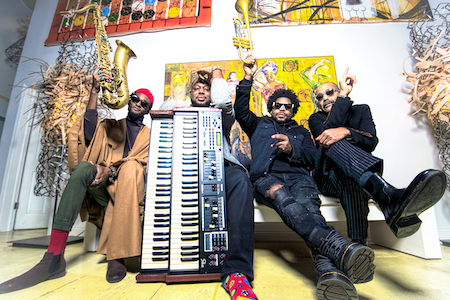Oct 28, 2025 10:47 AM
In Memoriam: Jack DeJohnette, 1942–2025
Jack DeJohnette, a bold and resourceful drummer and NEA Jazz Master who forged a unique vocabulary on the kit over his…

A Time For Healing band members, from left, Isiah Collier, Justin Dillard, Corey Wilkes and Kahil El’Zabar.
(Photo: Michael Jackson)The laid-back, metronomic bounce and slap of percussionist Kahil El’Zabar’s earth drum (in tandem with contrapuntal ankle bells) has been heard in Chicago and beyond for more than 50 years.
“The origin of this shape of drum comes from West and Central Africa, then to the West Indies to become conga drums,” El’Zabar says during a roundtable chat with his cross-generational quartet of trumpeter Corey Wilkes, saxophonist Isaiah Collier and keyboardist Justin Dillard, all featured on his latest release, A Time For Healing (SpiritMuse). “In the early ’60s, Chief Bey in NYC taught Black Harold from Chicago how to rope this drum with skin. … Harold taught this style to younger drummers. … We mastered this African-American drumming, different to traditional African, Latin-American or South American.”
The “we” El’Zabar speaks of was called the SunDrummer, and a solo piece on the new recording, “Drum Talk (Run’n In The Streets),” has its genesis in those formative days.
El’Zabar’s irrevocable percussion beats build in intensity through a long-form resolve. Yet, his kit drumming is untame, splashy, exultant, buoyed or goaded by vocal caterwauls. The latter are featured on “Resolution,” where his younger sidemen (El’Zabar is 68, Collier 24, for example) revisit John Coltrane’s call-to-creative-arms from 1964’s A Love Supreme.
Collier, a titanic tenor, had a chance to record at Rudy Van Gelder’s studio recently, on the same equipment that captured Trane’s landmark album, but his first hero was actually Trane’s sidekick, Pharoah Sanders.
“For the longest time I had a lot of stuff backwards and thought that Pharoah was the one who taught Trane,” laughs Collier, who’s mother thought he was being possessed by demons as a kid, listening endlessly to Sanders’ epic rendition of “Impressions” in his bedroom. Some of Sanders’ raspy expressionism, via Collier’s tenor, can be heard on the meditative title track, which is augured by the ancient clockwork of El’Zabar’s kalimba and the gentle piping of Chinese Hulusi flute, which was a gift to Collier from Dillard. “I go through periods with different instruments,” Dillard says. “I buy stuff and if I think it’s cool, after a while I give it away.”
Dillard’s Hammond keyboard — which, live, he plays casually on his lap — variously mimics guitar and acoustic bass sounds. He prods and percolates with an ear for the range and timbre of strings and woodwinds, which he puts down to countless gigs with bassist Junius Paul, guitarist Bobby Broom and flutist Nicole Mitchell, among others. Dillard inhabits several personas on El’Zabar’s tribute to multi-instrumentalist/funk pioneer Eddie Harris, with whom the percussionist first worked at Chicago’s Roadrunner Lounge in 1971. “My biggest lessons from Eddie, apart from understanding the impact of counterpoint and harmonic explorations, was how to count and hold time, maintaining tempos consistently,” El’Zabar says. “And also how big you can make your sound with an economical ensemble.”
Wilkes, a fiery musician, contributes balladry and subtlety to this release and credits long-term work in El’Zabar’s ensembles with strengthening his time. “Especially in the Ethnic Heritage Ensemble, where we have no chordal instrument at all, you have to rely on your intuition, your groove-ability, your ears — everything has to be honed into that thing that isn’t there,” Dillard says. “I learned from Corey, Corey learnt from Kahil. … When I started playing, I was ‘Mr. Notes,’ then Corey would call a tune that only had one or two changes and I would be lost in space.”
“Time IS,” one of the sleeper tracks from the set, shimmies infectiously without ostensible fanfare; the way each member of the quartet places their beat puts ants-in-pants; on the fade, Collier mimics hand-slap-on-drumskin with slap-tongue-on-reed.
At 1 hour and 18 minutes of deeply infused music, the project came together during the thick of the pandemic, and El’Zabar’s dolefully hopeful tune “We’ll Get Through This” says it all. The apparently ageless percussionist and music historian insists on accentuating the positive.
“We’ve come through chaos, health issues, awareness of racial and social injustices,” he says. “There’s an emotional shift toward a compass of integrity … we’re trying to transmit something universal, soulful and uplifting. We need it now, globally.” DB

Jack DeJohnette boasted a musical resume that was as long as it was fearsome.
Oct 28, 2025 10:47 AM
Jack DeJohnette, a bold and resourceful drummer and NEA Jazz Master who forged a unique vocabulary on the kit over his…

D’Angelo achieved commercial and critical success experimenting with a fusion of jazz, funk, soul, R&B and hip-hop.
Oct 14, 2025 1:47 PM
D’Angelo, a Grammy-winning R&B and neo-soul singer, guitarist and pianist who exerted a profound influence on 21st…

Kandace Springs channeled Shirley Horn’s deliberate phrasing and sublime self-accompaniment during her set at this year’s Pittsburgh International Jazz Festival.
Sep 30, 2025 12:28 PM
Janis Burley, the Pittsburgh International Jazz Festival’s founder and artistic director, did not, as might be…

Jim McNeely’s singular body of work had a profound and lasting influence on many of today’s top jazz composers in the U.S. and in Europe.
Oct 7, 2025 3:40 PM
Pianist Jim McNeely, one of the most distinguished large ensemble jazz composers of his generation, died Sept. 26 at…

Drummond was cherished by generations of mainstream jazz listeners and bandleaders for his authoritative tonal presence, a defining quality of his style most apparent when he played his instrument unamplified.
Nov 4, 2025 11:39 AM
Ray Drummond, a first-call bassist who appeared on hundreds of albums as a sideman for some of the top names in jazz…